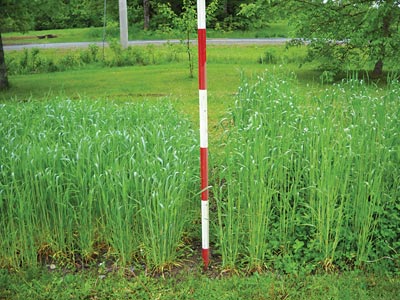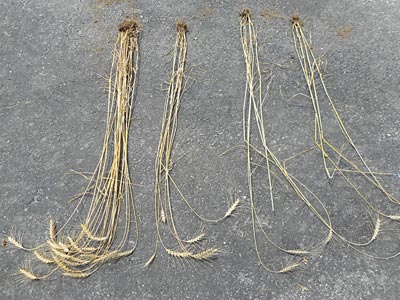 |
| Banatka wheat (8- x 8-inch spacing) with a Dutch white clover understory to the right of the range pole; Warthog on the left. Sowing Dutch white immediately after planting Banatka produced a beautiful, weed-free understory, but frost seeding Warthog was not so good. In a subsequent sowing of Banatka in both plots, the right side (underseeded with Dutch white) matured a week before the left (Warthog), weedy side. Dutch white outcompetes weeds and is low enough not to clog the mini-combine. |
 |
| Banatka plants grown with close spacing. The plant on the left, with wider spacing, had 16 tillers; the ones on the right were close and had five to six. The 2013 crop, with 8-inch spacing, had 10 to 19 tillers (averaging about 15) per plant. Although the 2014 crop yielded 163 to 1, compared to 140 to 1 earlier, the earlier, lower yield likely resulted from poor thresher settings. |
By Ben Hoffman
Photos by the author
Bob Mowdy and I have fooled around with cereal grains for about 10 years in Bradford, Maine. We have tried several varieties of wheat, barley and oats, including Banatka wheat, a winter-hardy Hungarian landrace bred by Eli Rogosa that is drought resistant and is excellent for baking. Bread from my first crop was space food – out of this world.
Rogosa recommends 8- x 8-inch spacing, which I followed in my first planting. At $20 an ounce for seed (available from Fedco Seeds), you need to follow directions. I tried modifying an Earthway seed plate but ended up planting each seed individually by hand. The resulting stand was 5 to 6 feet tall with 10 to 19 tillers per plant and with grain heads 4 to 5 inches long. The yield on my first (2013) crop was 140 seeds produced for each seed planted, despite losses from threshing with an improper chaff setting. UMaine plots that were drilled in the conventional manner yielded more per acre but much less per plant.
For 2014, I modified two seed plates, sowing one plot with three or four seeds per linear foot and another with six seeds per linear foot, in rows 8 inches apart. The three- to four-seed setting yielded 163 seeds per planted seed, but the plot sown with the six-seed setting was contaminated by volunteers from an adjacent planting of another variety. With less growing space, plants spaced at three or four per linear foot had fewer tillers. The best had 15, the poorer ones only two to six. Where two plants grew side by side, roots intertwined and plants produced fewer tillers.
In 2015, I modified two Earthway plates to sow 7-1/2- and 9-inch spacings. Earthway publishes a guide to modify seed plates using beeswax to fill unused seed openings and to size openings for grains. Unfortunately, the irregular, rough grain seeds adhered to the wax. I accidentally discovered that partially blocking the cucumber plate with styrene strips worked well, and a few modifications to the carrot plate with a Dremel tool worked almost as well. I used the cucumber plate with 9-inch spacing.
One reason to plant cereal grains densely (19 or more plants/square foot) is to control weeds. I tried Dutch white clover sown either shortly after the Banatka (best) or frost seeded in spring or fall. Dutch white forms a low, dense understory that controls weeds, fixes nitrogen in the soil and remains as a cover crop after the grain harvest. Because Banatka is so tall, I tried red clover in one plot, but it climbed up to 4 feet and pulled many stems down.
My Thorndike stony loam (read “loamy stone”) soil has been ridden hard and put away wet. Adding wood ash has boosted the pH to about 6 and boosted potassium, but the soil needs more phosphorus. Manure, ash and stones supply most of the other necessary nutrients, but fertility still needs to be improved. I plan to strip/zone-till corn and dry beans in the clover and would like to try no-till in Dutch white as a living mulch.
Both Mowdy and I have tried discing and broadcast seeding, a home-made drill and a Chinese mini-combine, mostly on plots of 1/4 to 1/2 acre. I now have three plots, each about 1/3 acre in size, that produce enough Banatka grain for bread, and barley and oats for cereal and for feeding the livestock next door.
About the author: Ben Hoffman has degrees in forestry and has worked for the U.S. Forest Service, the Vermont Forest Service, Weyerhaeuser and the University of Maine. He has also taught forestry in British Columbia and Alaska. He returned to Maine in 2001 to dabble in consulting and writing and to play with trains.
